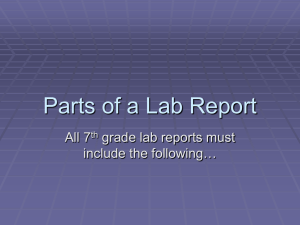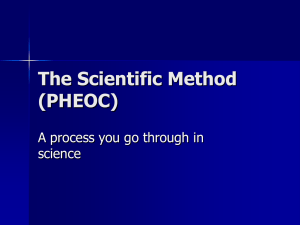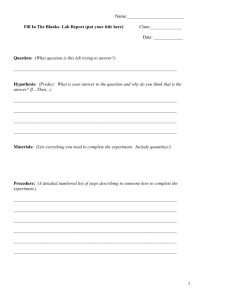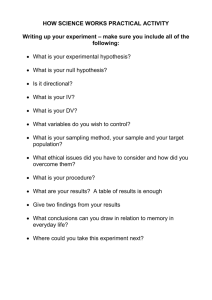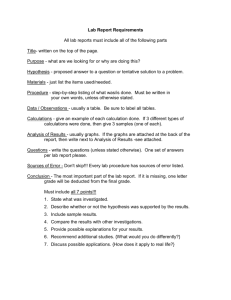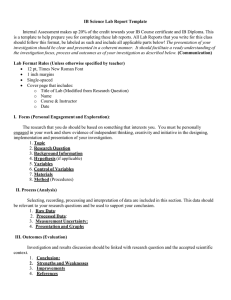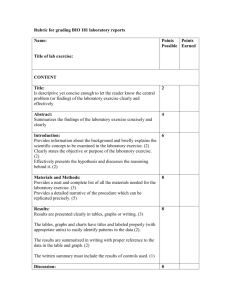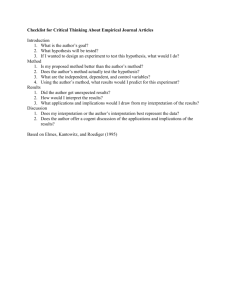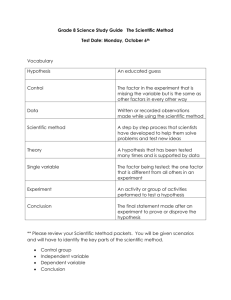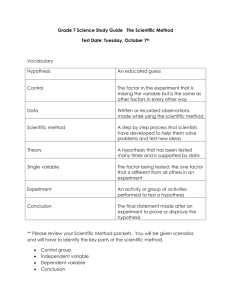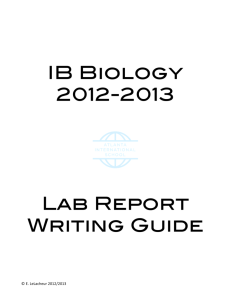IB Biology Lab Report Template
advertisement
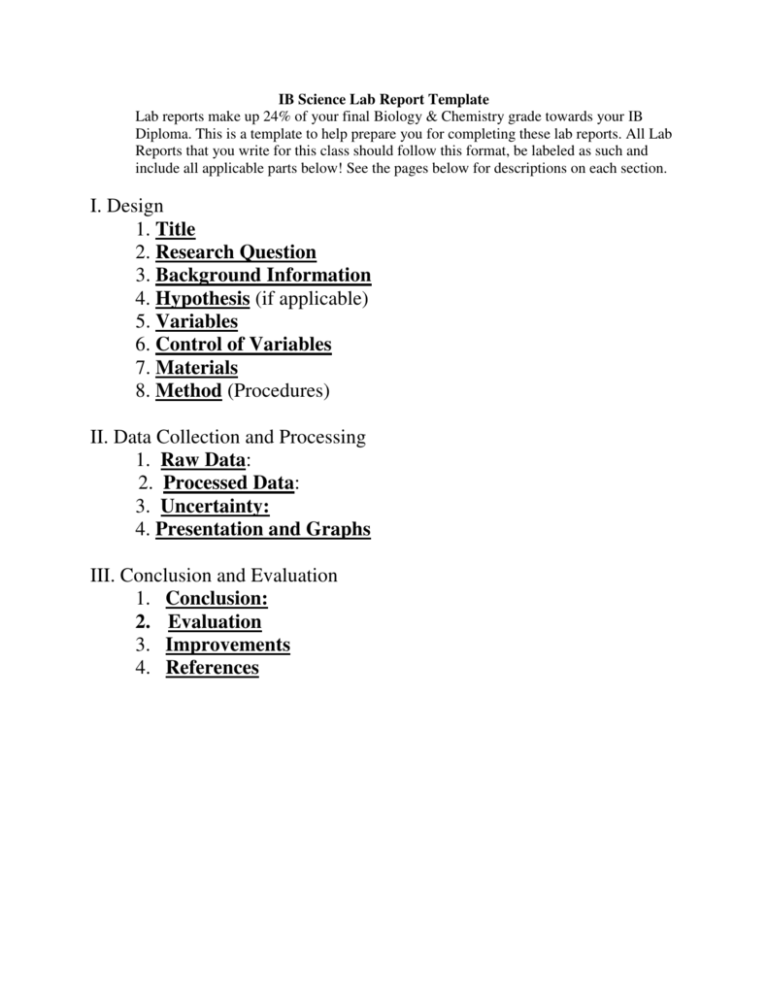
IB Science Lab Report Template Lab reports make up 24% of your final Biology & Chemistry grade towards your IB Diploma. This is a template to help prepare you for completing these lab reports. All Lab Reports that you write for this class should follow this format, be labeled as such and include all applicable parts below! See the pages below for descriptions on each section. I. Design 1. Title 2. Research Question 3. Background Information 4. Hypothesis (if applicable) 5. Variables 6. Control of Variables 7. Materials 8. Method (Procedures) II. Data Collection and Processing 1. Raw Data: 2. Processed Data: 3. Uncertainty: 4. Presentation and Graphs III. Conclusion and Evaluation 1. Conclusion: 2. Evaluation 3. Improvements 4. References I. Design 1. Title Short statement summarizing what this lab is about 2. Research Question Although the general aim of the investigation may be given by the teacher, students must identify a focused problem or specific research question. Unlike the title above which might be vague, you need to identify in this section a focused research question that is in the form of an actual question. As well, you should also include a brief description of your experiment. 3. Background Information This is information you need to provide pertaining to the experiment. You will need to refer to various sources to gain the knowledge necessary to write a hypothesis and carry out a valid experiment. 4. Hypothesis (Prediction) While a hypothesis is not required and sometimes is not possible in a formal IB IA (Internal Assessment) Lab, usually in this class you will try to include a hypothesis. If you include a hypothesis to help focus your research question then it needs to be an “if….then…” statement that includes the independent and dependent variables. Your hypothesis should be supported with an explanation and remember, a hypothesis is an “educated” guess, not a “random” guess and should be supported by your initial review of resources. Ex: If the glucose concentration is increased, then the amount of C02 produced will also increase. This is because glucose is used by yeast to make ATP through cellular respiration. The more glucose that is available, the faster the rate of cell respiration, and the more C02 that will be produced. C02 is a product of cell respiration in yeast, so the more C02 the faster the rate of cell respiration. 5. Variables: (Factors that can be measured or controlled) You must list out and identify all of the following: a. Independent Variable: The variable that YOU manipulate (change), and the result of this manipulation leads to the measurement of the dependent variable (Make sure that you choose only one independent variable to change. Some people inadvertently choose more than one.) b. Dependant Variable: The variable that changes when you change the independent variable (what you measure). c. Control Variable (Constant): 1. The control group in an experiment is the group that nothing is done to. The control is left alone so that the other variables may be compared to it. 6. Control of Variables This is not the same as “the control” above! All the aspects of the experiment that must be kept constant to ensure that the tests/experiment is valid. There will be several of these not just one! You must be thorough and think of as many controlled variables as you can. That said, don’t include controlled variables that aren’t significant. For example if you’re measuring the growth of yeast then the temperature definitely needs to be controlled (assuming temperature is not your independent variable) but the same location is not going to be a significant factor. Your must explicitly indicate how each controlled variable identified in your variables section was controlled. If you can’t actively control a variable then your method should include a means of monitoring it. 7. Materials You need to have a detailed and thorough list of equipment used in your investigation Make sure when writing up your equipment list that you include: • The sizes of glassware such as beakers, flasks, etc. • The concentration of chemicals (eg hydrochloric acid, 2.0 M). • The amounts of chemicals (eg magnesium, 0.50 g). • The range of a thermometer (eg –20°C to 120°C) • The amount of each solution (eg 200 mL) 8. Method (Procedures) You will write your own method, I won’t supply one for you to “copy”. Use “impersonal language”; which means no words such as “I”, “we”, “they”, etc. Ex: “I weighed out 0.50 g of magnesium and then I added 2.0 cm3 of 2M hydrochloric acid” should be rewritten as “Add 0.5 g magnesium to 200 cm3 of 2M hydrochloric acid” Make sure you record the amounts of materials to a sufficient precision in your method. Ex: If you weighed 20 g of magnesium using a volumetric pipette this should be recorded as 20.00 g and not just 20 g. Why? Because the scale has a precision of two decimal points Don’t include “obvious” steps in your methods. Steps such as: “collect and put on safety equipment” or “clean up bench and return apparatus to the trolley. These steps would be relevant to pretty much any experiment and so don’t need to be included. While writing up your method in “dot point” or numbered form is acceptable, real scientists actually write their methods in paragraph form – try it. Sometimes the best thing to do for your method is to draw a diagram (called a protocol diagram) of the experimental set up and refer to it. That’s fine if you do a diagram that is of a suitable size and reasonably detailed. Don’t sketch some doodle on the back of your report two minutes before you’re about to hand it in. See example below. Protocol Diagram showing “methods:” When designing a method, ensure that you change the independent variable enough times to collect enough points for a reasonable line of best fit. A minimum of five data points is required for any graph and more should be collected if time and materials allow. Consider whether or not the graph needs many data points or whether more repeating would be more worthwhile. If the graph has a complex shape e.g. a titration or cooling curve, then the more points the better. If the graph is linear then repeating the experiment for each point would be a better way to improve the correlation coefficient than simply collecting more points (assuming you already have 8 – 10 points). The method should include sufficient repeats of trials to ensure that random errors are at least minimized. Don’t leave this for your evaluation as repeating the experiment is a pretty lame suggestion – doubly so if you should have had it in your method in the first place. 5X5 Experimental Design is BEST!! (5 forms of independent variable with 5 repeats of an experiment) II. Data Collection and Processing 1. Raw Data: Qualitative (Observations) & Quantitative (numerical values) Make sure you record RAW data in tables and include it in your lab report. Raw data is the actual data measured in your experiment. Ex: If you are interested in the change in temperature of a reaction, record the initial and final temperature as seen below: Initial Temp (°C ± 0.5°C): 18 Raw Data Final Temp (°C ± 0.5°C): 49 Temp. Change (°C ± 1.0°C): 31 Processed Data The temperature change is a result of processing the data and cannot be recorded as raw data. Don’t mix quantitative and qualitative data in the same column if you have both. 2. Processed Data: When you take the data and do something to it, like find averages, slopes, changes, standard deviations, etc. this is processing the data. In any lab report you must have both raw and processed data included. Processed data should also be placed in tables in your lab report and then converted to graphs. Make sure you process the raw data CORRECTLY! Use headings in tables and graphs where possible to explain what section or step of the calculation you are doing. (See example above) 3. Uncertainty: Uncertainty is not the same as error. A value that is in error is incorrect. It is not a true measure of reality. A value can be entirely correct but, no matter what, it can only be measured to a certain limit of precision – to only so many “decimal places”. This limit of precision is quantified as the uncertainty. The uncertainty for a piece of apparatus is either printed on the apparatus (ex: burette, volumetric glassware) or as a general rule of thumb is half the smallest measurable or cited value. Ex: If a balance can measure to two decimal places (0.01 g) then the error in a mass reading with this balance is ±0.005 g. An exception to the uncertainty being half the smallest instrument value is when using a stopwatch. According to the display you can measure time to the nearest 100th of a second (0.01 s) with our stopwatches. Based on this the uncertainty would be ±0.005 s – but somehow I doubt your reflexes are this good. A more reasonable value would be ±0.5 seconds. In IB Biology, errors bars should also be included in your graphs. 4. Presentation (Tables and Graphs) You must show graphic representation of your processed data. Also make sure: • Your data collection must not look the same as anyone else’s! • The units are included (they should be cited ONCE in brackets in each column heading. Don’t put the units after each piece of data) • The uncertainty of the quantitative data and the units of the uncertainty need to be recorded once in the column heading • All data in a column must be given to the same number of decimal places • Tables and columns need a border with data centered in the column. • The table needs to have a suitable and descriptive heading (“Table 1”, “Data Collection” or “Results” are not suitable headings). • Using Microsoft Excel may be the best choice for creating graphs III. Conclusion and Evaluation 1. Conclusion: State a conclusion, with justification, based on a reasonable interpretation of the data: Ensure that you quote any quantitative results in your conclusion even if the quantitative results are mentioned elsewhere in your report. That said don’t just restate your results. Draw conclusions from them. Remember a hypothesis can only be supported or refuted. It cannot be “proven”! Don’t forget to compare your results to the literature. This may be quantitative literature values, manufactures claims or established theories. If you are comparing quantitative results express any difference between your value and the literature value as a percentage of the literature value. Statements such as “our results were very close to the literature values” are not enough – how close are they as a percentage? Conclusions such as “The results confirm my hypothesis” will not be accepted – especially if the results don’t “confirm” your hypothesis and even if they do. You must explain why/how your results support or invalidate your hypothesis (if you have a hypothesis). You can do this by referring to specific observations, the gradients/shapes of graphs or values collected/calculated. You need to show that you understand how your results support or invalidate your hypothesis. 2. Evaluation Evaluate weaknesses and limitations. Do this by analyzing your sources of error. Distinguish between systematic and random errors. • Are there flaws in the procedures used which could affect the result? • Were important variables not controlled? • Are the measurements and observations reliable? • Is the accuracy of a result unknown because of a lack of replication? • What assumptions are being made? 3. Improvements You must suggest improvements to the PROCEDURE. Complaining about not having enough time or being disorganized has nothing to do with the procedure. You need to suggest a minimum of 3 significant improvements. Anything less will result in a partial. You must explain why the improvements will lead to a reduction in systematic or random error. Suggestions that lead to increased precision are only worthwhile for experiments that require precise measurements (in an IB Biology class, precision experiments are rare). Suggestions such as “collect more data”, while valid and should be included with an explanation when appropriate, are fairly obvious and on their own are insufficient. Some suggestions such as “be more careful” are lame. All you’re saying with a phrase like this is that you were careless on the day and you then will be marked down for Manipulative skills. ** Mistakes - errors should not be confused with mistakes, such as spilling half of the chemical you just carefully weighed to the nearest milligram between the balance and volumetric flask. If a mistake is made you just have to start again. As far as your evaluations go, you do not need to mention or discuss mistakes – we all make them. 4. References If you use someone else's ideas in your lab report you need to acknowledge them. This includes in-text referencing and a works cited page. In science we use APA format so all lab reports and citations should be done in this manner.
